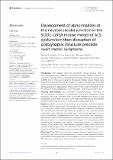Files in this item
Development of abnormalities at the neuromuscular junction in the SOD1-G93A mouse model of ALS : dysfunction then disruption of postsynaptic structure precede motor symptoms
Item metadata
| dc.contributor.author | McIntosh, Jayne | |
| dc.contributor.author | Mekrouda, Imane | |
| dc.contributor.author | Dashti, Maryam | |
| dc.contributor.author | Giuraniuc, Claudiu | |
| dc.contributor.author | Banks, Robert W. | |
| dc.contributor.author | Miles, Gareth Brian | |
| dc.contributor.author | Bewick, Guy S. | |
| dc.date.accessioned | 2023-05-19T09:30:10Z | |
| dc.date.available | 2023-05-19T09:30:10Z | |
| dc.date.issued | 2023-05-19 | |
| dc.identifier | 284381570 | |
| dc.identifier | f62bddf3-2ce1-4d03-8675-abc07106794a | |
| dc.identifier | 85161088402 | |
| dc.identifier.citation | McIntosh , J , Mekrouda , I , Dashti , M , Giuraniuc , C , Banks , R W , Miles , G B & Bewick , G S 2023 , ' Development of abnormalities at the neuromuscular junction in the SOD1-G93A mouse model of ALS : dysfunction then disruption of postsynaptic structure precede motor symptoms ' , Frontiers in Molecular Neuroscience , vol. 16 , 1169075 . https://doi.org/10.3389/fnmol.2023.1169075 | en |
| dc.identifier.issn | 1662-5099 | |
| dc.identifier.other | ORCID: /0000-0002-8624-4625/work/135454696 | |
| dc.identifier.uri | https://hdl.handle.net/10023/27647 | |
| dc.description | Funding: This project was funded by a PhD studentship to JM from Motor Neurone Disease Scotland, on grant number RGB5753 to GSB and GBM. | en |
| dc.description.abstract | The ultimate deficit in ALS is neuromuscular junction (NMJ) loss, producing permanent paralysis, ultimately in respiratory muscles. However, understanding the functional and structural deficits at NMJs prior to this loss is crucial for therapeutic strategy design. Should early interventions focus on reversing denervation, or supporting largely intact NMJs that are functionally impaired? We therefore determined when functional and structural deficits appeared in diaphragmatic NMJs relative to the onset of hindlimb tremor (the first overt motor symptoms) in vivo in the SOD1-G93A mouse model of ALS. Significant reduction in the amplitudes of spontaneous miniature endplate potentials (mEPPs) and evoked EPPs emerged only at early symptomatic ages (in our colony, 18-22 weeks). Reductions in mEPP frequency, number of vesicles per EPP, and EPP rise time were seen earlier, at 16weeks, but this reversed by early symptomatic ages. However, the earliest and most striking impairment was an inability to maintain EPP amplitude during a 20 Hz stimulus train, which appeared 6 weeks before overt in vivo motor symptoms. Despite this, fluorescent α-bungarotoxin labelling revealed no systematic, progressive changes in 11 comprehensive NMJ morphological parameters (area, shape, compactness, number of acetylcholine receptor, AChR, regions, etc.) with disease progression. Rather, while NMJs were largely normally-shaped, from 16 weeks there was a progressive and substantial disruption in AChR concentration and distribution within the NMJ footprint. Thus, NMJ functional deficits appear at least 6 weeks before motor symptoms in vivo, while structural deficits occur 4 weeks later, and predominantly within NMJs. These data suggest initial therapies focused on rectifying suboptimal NMJ function could produce effective relief of symptoms of weakness. | |
| dc.format.extent | 16 | |
| dc.format.extent | 6495017 | |
| dc.language.iso | eng | |
| dc.relation.ispartof | Frontiers in Molecular Neuroscience | en |
| dc.subject | Neuromuscular junction | en |
| dc.subject | Motor neuron disease | en |
| dc.subject | Neuromuscular transmission | en |
| dc.subject | SOD1-G93A | en |
| dc.subject | ALS | en |
| dc.subject | Acetylcholine receptor | en |
| dc.subject | Mouse | en |
| dc.subject | RC0321 Neuroscience. Biological psychiatry. Neuropsychiatry | en |
| dc.subject | DAS | en |
| dc.subject | MCC | en |
| dc.subject.lcc | RC0321 | en |
| dc.title | Development of abnormalities at the neuromuscular junction in the SOD1-G93A mouse model of ALS : dysfunction then disruption of postsynaptic structure precede motor symptoms | en |
| dc.type | Journal article | en |
| dc.contributor.institution | University of St Andrews. Office of the Principal | en |
| dc.contributor.institution | University of St Andrews. Sir James Mackenzie Institute for Early Diagnosis | en |
| dc.contributor.institution | University of St Andrews. Centre for Biophotonics | en |
| dc.contributor.institution | University of St Andrews. School of Psychology and Neuroscience | en |
| dc.contributor.institution | University of St Andrews. Institute of Behavioural and Neural Sciences | en |
| dc.identifier.doi | 10.3389/fnmol.2023.1169075 | |
| dc.description.status | Peer reviewed | en |
This item appears in the following Collection(s)
Items in the St Andrews Research Repository are protected by copyright, with all rights reserved, unless otherwise indicated.

